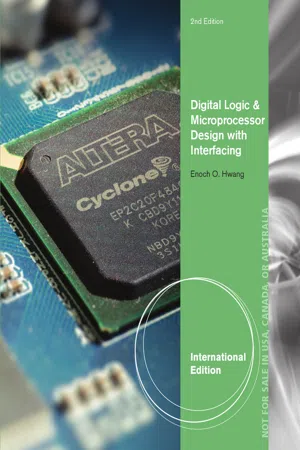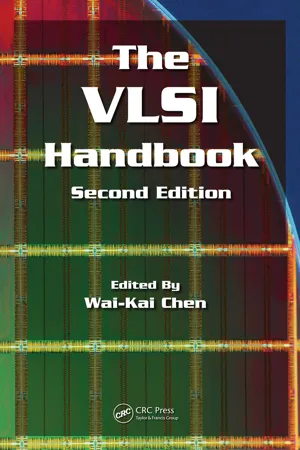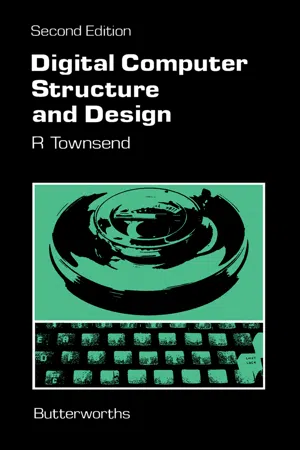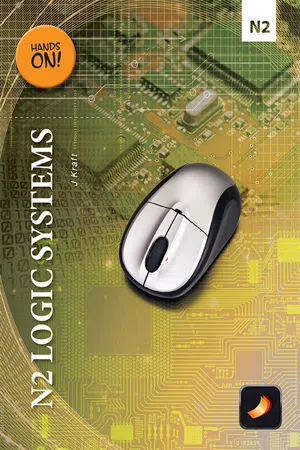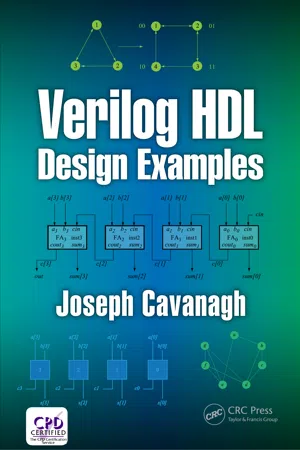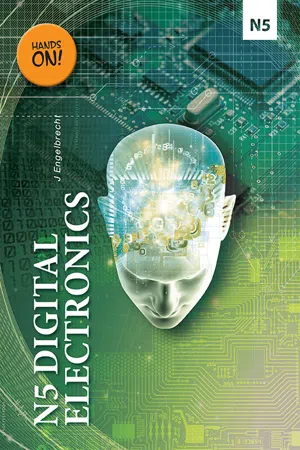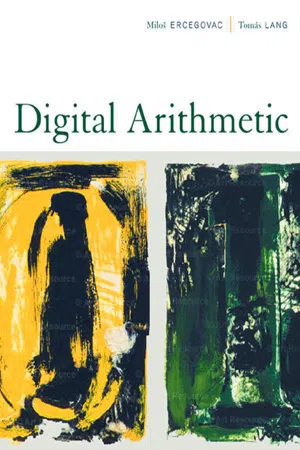Physics
2-Bit Adder
A 2-bit adder is a digital circuit that adds two 2-bit binary numbers. It consists of logic gates that perform the addition operation, including XOR gates for the sum and AND gates for the carry. The output of the 2-bit adder provides the sum of the two input binary numbers along with a carry out bit.
Written by Perlego with AI-assistance
Related key terms
1 of 5
12 Key excerpts on "2-Bit Adder"
- Dennis L. Eggleston(Author)
- 2011(Publication Date)
- Cambridge University Press(Publisher)
To see this, consider the data in Table 8.5 . We imagine that A and B are two binary numbers consisting of one bit, so each can only have the value 0 or 1. 214 Digital circuits and devices Table 8.5 Adding two one-bit binary numbers A B Sum C S 0 0 0 0 0 1 0 1 0 1 0 1 1 0 1 1 1 10 1 0 A B S C Figure 8.26 A half-adder made from an AND gate and an OR gate. Our table shows the four possible combinations for A and B and their sum. Note that the last entry ( 1 + 1 = 10 ) requires two bits for the sum. We separate these two bits in the columns C and S . If we think of columns C and S as outputs for a logic circuit having inputs A and B , we see that C is provided by the AND logic and S is given by XOR logic. We can thus perform this one-bit addition with the circuit of Fig. 8.26 . This circuit is called a half-adder , which we will abbreviate HA. S stands for sum and C stands for carry . Adding one-bit binary numbers is nice, but usually our arithmetic needs will involve longer binary numbers. Perhaps we can use a series of n half-adders to add an n -bit binary number. Unfortunately, this does not work. If we review the binary addition example in Table 8.2 , we see that each column of the addition requires three possible inputs: one from each number and one to accommodate the possibility of a carry from the sum of the digits to the right. The half-adder outputs a sum and a carry but has no provision for a carry input . The solution to this problem, shown in Fig. 8.27 , uses two half-adders and an OR gate. This new circuit is called a full adder (FA). The full adder has three inputs, thus allowing for a carry input from the result of a previous addition. The output has a carry and a sum, just as for the half-adder. The reader can verify the proper operation of this device by working through the logic for all possible input combinations. 8.8 Adders 215 C A B S C C S C S HA HA Figure 8.27 A full-adder made from two half-adders and an OR gate.- Enoch Hwang(Author)
- 2017(Publication Date)
- Cengage Learning EMEA(Publisher)
To make things simpler, we work with a digital abstraction of our analog world. Instead of working with an infinite continuous range of values, we use just two values, 1 and 0, to represent the two states, on and off, in a digital electronic circuit. It cer-tainly is much easier to control and work with two values rather than an infinite range of values. We call these two values binary values because there are only two of them. A single 0 or a single 1 is a binary digit or bit for short (where “bi” comes from the first two letters of the word “binary,” and “t” comes from the last letter of the word “digit”). This sounds great, but we have to remember that the underlying building block for our digital circuits is still based on an analog world. This chapter provides the theoretical foundations for building digital logic circuits using logic gates, the basic building blocks for all digital circuits. We start with an intro-duction on working with binary numbers and performing simple arithmetic in binary. We then will introduce the basic logic gates for building digital circuits. Next, we cover the basic theory of Boolean algebra, Boolean functions, and how to use and manipulate them. Many students may find these theories to be boring and difficult to understand, but let me encourage you to grind through it patiently. The good news is that I will try to keep them as short and simple as possible. You also will find that many of the Boolean theorems are very familiar, because they are similar to the algebra theorems that you already learned in your high school math class. Finally, we conclude with an example of building a simple digital circuit. 2.1 Binary Numbers Because digital circuits deal with binary values, we will begin with an introduction to binary numbers . A bit, having a value of either 0 or 1, can represent only two things or two pieces of information. It is, therefore, necessary to group together many bits to represent more pieces of information.- eBook - PDF
- Wai-Kai Chen(Author)
- 2018(Publication Date)
- CRC Press(Publisher)
41 -1 © 2006 by CRC Press LLC 41 Adders CONTENTS 41.1 Introduction ........................................................... 41- 1 41.2 Addition in the Binary Number System .............. 41- 1 41.3 Serial Adder ............................................................ 41- 3 41.4 Ripple Carry Adder ................................................ 41- 4 41.5 Carry Skip Adder ................................................... 41- 7 41.6 Carry Look-Ahead Adder ...................................... 41- 8 41.7 Carry Select Adder ............................................... 41- 10 41.8 Carry Save Adder ................................................. 41- 11 References ........................................................................ 41- 11 41.1 Introduction Adders are the most common arithmetic circuits in digital systems. Adders are used to do subtraction and also are key components of multipliers and dividers, as described in Chapters 42 and 43. There are various types of adders with different speeds, areas, and configurations. We can select an appropriate one which satisfies given requirements. For the details of adders and addition methods, see Refs. 2, 4–6, 12, 15, 17, and 20. 41.2 Addition in the Binary Number System Before considering adders, let us take a look at addition in the binary number system. In digital systems, numbers are usually represented in the binary number representation, although the most familiar number representation to us is the decimal number representation. The binary number representation is with the radix (base) 2 and the digit set {0, 1}, while the decimal number representation is with the radix 10 and the digit set {0, 1, 2,…, 9}. For example, a binary number (i.e., a number in the binary number representation) [1101] represents 1·2 3 + 1·2 2 + 0·2 1 + 1·2 0 = 13, whereas a decimal number (i.e., a number in the decimal number representation) [8093] for example, represents 8·10 3 + 0·10 2 + 9·10 1 + 3·10 0 = 8093. - eBook - PDF
The Computing Universe
A Journey through a Revolution
- Tony Hey, Gyuri Pápay(Authors)
- 2014(Publication Date)
- Cambridge University Press(Publisher)
These are followed by the figure and height of an average man, the population of Earth, the position of the planet in our solar system, and the dimensions of the radio antenna broadcasting this message. 29 The hardware construct any logical operation with any number of inputs and outputs. There are also other possible choices for such a “complete set” of gates. Let’s see how this all works by building a “bit-wise adder” black box from our basic AND, OR, and NOT building blocks. The bit-wise adder has two inputs – the bits A and B to be added – and two outputs – the result R and the carry C, if there is one (Fig. 2.12). We need to combine AND, OR, and NOT gates appropriately to produce this logical behavior. First we note that the table for the carry bit is identical to that of the AND gate. We can write: Carry C: A AND B The table for the result R is almost the same as that for the OR gate except for the result for the 1 + 1 input when the output must be inverted. The result R is therefore A OR B unless A AND B is 1. After some thought we can write this as: Result R: (A OR B) AND NOT (A AND B) This leads to the implementation of the bit-wise adder shown in Figure 2.13. This circuit is actually called a “half-adder” because although it correctly produces the carry value, it does not include a possible carry as an input to the device, as well as A and B. Using the half-adder of Figure 2.13, we can easily cre- ate an implementation for a “full adder” (Fig. 2.14). Adders for words with any number of bits can now be created by chaining these full adders together. These examples illustrate two key principles of computer design. The first principle is that we rely on a “hierarchical design” process by which complex objects are built up from simpler objects. Logic gates are our fundamental and A B A AND B 0 0 0 0 1 0 1 0 0 1 1 1 A AND B A B A B A OR B 0 0 0 0 1 1 1 0 1 1 1 1 A B A OR B A NOT A 0 1 1 0 A NOT A Fig. - eBook - PDF
- R. Townsend(Author)
- 2014(Publication Date)
- Butterworth-Heinemann(Publisher)
A somewhat different approach to the problem of fast binary addition has been adopted by the Manchester University Computer Group, and others. With this point of view the adder and the accumulator register are considered as a single combined device in which the objective is to place the result in the register in the shortest time. In the adder for the Atlas computer 11 a special purpose circuit is designed which derives its speed from the fast propagation of the carry signal from the collector to the emitter of a saturated symmetrical transistor. However this technique is no longer suitable for modern integrated circuit technology. The need for high speed binary adders becomes most important on very large and fast computers having word lengths of 50 to 100 bits, in which the carry propagation time with a conventional ripple carry 106 Addition and Subtraction adder has a serious effect on the performance. With the availability of small lookahead adders complete on integrated circuits, it is now worth while to incorporate these in minicomputers. In any case, the speed of integrated circuit logic gates is continually rising, which makes for a very high performance with conventional methods. The lookahead adder seems to be the preferred method for improving speed on modern large machines. Binary Coded Decimal Adders Most modern processors operate with pure binary numbers, but decimal arithmetic units are still of interest in electronic calculators and special purpose devices, such as point of sale cash registers. The decimal numbers are usually represented as a binary code, the commonest being the straightforward BCD or 1248 weighted code. The 'excess 3' code has been widely used in the past, and is still popular in some applications. The rules of binary coded decimal arithmetic with the BCD and 'excess 3' codes have been described in Chapter 4. - eBook - PDF
- Wai-Kai Chen(Author)
- 2003(Publication Date)
- CRC Press(Publisher)
0-8493-1734-7/03/$0.00+$1.50 © 2003 by CRC Press LLC 16-1 16 Adders 16.1 Introduction ...................................................................... 16-1 16.2 Addition in the Binary Number System .......................... 16-1 16.3 Serial Adder ....................................................................... 16-3 16.4 Ripple Carry Adder ........................................................... 16-4 16.5 Carry Skip Adder ............................................................... 16-6 16.6 Carry Look-Ahead Adder ................................................. 16-8 16.7 Carry Select Adder ............................................................ 16-9 16.8 Carry Save Adder ............................................................. 16-11 16.1 Introduction Adders are the most common arithmetic circuits in digital systems. Adders are used to do subtraction and also are key components of multipliers and dividers, as described in Chapters 17 and 18. There are various types of adders with different speeds, areas, and configurations. We can select an appropriate one which satisfies given requirements. For the details of adders and addition methods, see Refs. 2, 4–6, 12, 15, 17, and 20. 16.2 Addition in the Binary Number System Before considering adders, let us take a look at addition in the binary number system. In digital systems, numbers are usually represented in the binary number representation, although the most familiar number representation to us is the decimal number representation. The binary number representation is with the radix (base) 2 and the digit set {0, 1}, while the decimal number representation is with the radix 10 and the digit set {0, 1, 2, …, 9}. - eBook - ePub
Modern Computer Architecture and Organization
Learn x86, ARM, and RISC-V architectures and the design of smartphones, PCs, and cloud servers
- Jim Ledin(Author)
- 2020(Publication Date)
- Packt Publishing(Publisher)
out is 0.The circuit in Figure 2.15 can be condensed to a schematic block with three inputs and two outputs for use in higher-level diagrams. Figure 2.16 is a four-bit adder with four blocks representing copies of the full adder circuit of Figure 2.15 . The inputs are the two words to be added, A 0 -A 3 and B 0 -B 3 , and the incoming carry, C in . The output is the sum, S 0 -S 3 , and the outgoing carry, C out :Figure 2.16: 4-bit adder circuitIt is important to note that this circuit is a combinational circuit, meaning that once the inputs have been set, the outputs will be generated directly. This includes the carry action from bit to bit, no matter how many bits are affected by carries. Because the carry flows across bit by bit, this configuration is referred to as a ripple carry adder . It takes some time for the carries to propagate across all the bit positions and for the outputs to stabilize at their final value.Since we are now discussing a circuit with a signal path that passes through a significant number of devices, it is appropriate to discuss the implications of the time required for signals to travel from end to end across multiple components.Propagation delay
When the input of a logic device changes, the output does not change instantly. There is a time delay between a change of state at the input and the final result appearing at the output called the propagation delay .Placing multiple combinational circuits in series results in an overall propagation delay that is the sum of the delays of all the intermediate devices. A gate may have a different propagation delay for a low-to-high transition than for a high-to-low transition, so the larger of these two values should be used in the estimation of the worst-case delay. - Available until 8 Feb |Learn more
- J Kraft(Author)
- 2013(Publication Date)
- Future Managers(Publisher)
Such a circuit is illustrated in figure 2.3 (a) and the IEC-circuit symbol in figure 2.3 (b). H/A H/A 1 F /A A C O C O C IN C IN B B A Sum Sum (a) (b) Figure 2.3 26 Module 2 • Number systems The truth table for a full adder is given in table 2.3. A B C in Sum C o 0 0 0 0 0 0 0 1 1 0 0 1 0 1 0 0 1 1 0 1 1 0 0 1 0 1 0 1 0 1 1 1 0 0 1 1 1 1 1 1 Table 2.3 Just as in the case of the half-adder, the full-adder may also be constructed using NAND-gates and is illustrated in figure 2.4. & & & & & & & & & A Sum C O C IN B Figure 2.4 The parallel-adder Since the half-adder as well as the full adder can only add two binary digits together, provision has to be made to add more than one set of binary digits or numbers. Such a four-bit parallel adder is illustrated in figure 2.5. It has to be mentioned that the LSB full adder may be replaced by a half-adder since there is no previous ‘carry in‘, otherwise the full adder as indicated has to be kept at zero (0). 27 N2 Logic Systems | Hands On! F /A C OUT C IN F /A C OUT C IN F /A C OUT C IN F /A C OUT C IN 0 A 1 S 4 S 2 S 1 B 8 B 4 B 2 B 1 A 8 A 4 A 2 S 8 Figure 2.5 2.5.3 Binary subtraction Definition: Binary subtraction may be seen as the manipulation of two sets of data by subtracting them from one another to obtain a single result or data set. In the binary number system the following rules for subtraction apply. 0 − 0 = 0 Rule 1 0 − 1 = 1 Rule 2 provided there is a more significant bit, ie 1 to the left 1 − 0 = 1 Rule 3 1 − 1 = 0 Rule 4 Example 4 Convert the following decimal numbers to their equivalent binary numbers and then subtract the binary numbers. - eBook - PDF
Engineering Digital Design
Revised Second Edition
- Richard F. Tinder(Author)
- 2000(Publication Date)
- Academic Press(Publisher)
CHAPTER 8 Arithmetic Devices and Arithmetic Logic Units (ALUs) 8.1 INTRODUCTION In this chapter digital circuits will be designed with electrical capabilities that can be interpreted as performing the basic arithmetic operations of binary numbers. The basic operations include Addition Subtraction Multiplication Division Now, Boolean equations are uniquely defined so as to perform specific arithmetic operations, and the 1’s and 0’s, which have previously been used only as logic levels, must take on a numerical significance. The reader must keep in mind that an arithmetic circuit is only the electrical analog of the arithmetic operation it represents. In fact, it is the interpretation of the electrical circuit’s behavior that bridges the gap between physical and logic domains. The treatment of arithmetic circuits presented in this text is not intended to be a treatise on the subject. Rather, the intent is to introduce the subjects at both the beginning and intermediate-to-advanced levels utilizing, where necessary, appropriate algorithms for the basic operations in question. The subjects of arithmetic logic units (ALUs) and the applica-tion of dual-rail methods, which are covered in later sections, fall within the intermediate-to-advanced level of coverage and may not be expected to be part of a first-level course in digital design. 8.2 BINARY ADDERS Because of the nature of binary and the requirements for arithmetic manipulation, ap-proaches to basic adder design vary considerably depending on the form the manipulation takes. There are ripple-carry adders, carry-save, carry select, and carry-look-ahead adders, 335 336 CHAPTER 8 / ARITHMETIC DEVICES AND ARITHMETIC LOGIC UNITS (ALUs) the last three being classified as “high-speed” adders. This list of four does not nearly cover the scope of adder design, nor does it establish the general character of these arithmetic devices. - eBook - ePub
- Joseph Cavanagh(Author)
- 2017(Publication Date)
- CRC Press(Publisher)
2 .Table 4.1 Truth Table for a Full Adder for Binary AdditionThe radix complement of binary numbers (2s complement ) is obtained by complementing each bit of the corresponding positive binary number and adding 1 to the low–order bit position. For example, let A = 0001 11002 = +2810 and A’ = 1110 0011 = 1110 0100 = –28. To obtain the value of a negative number count the weight of the 0s and add 1. Examples of addition operations are shown in Table 4.2 , which add two 8-bit positive and negative operands.Table 4.2 Examples of Addition for Two Eight-Bit Signed Operands4.12.1 Full AdderA full adder can be designed from two half adders. A half adder adds two operand bits a and b, and produces two outputs sum and carry-out . The truth table for a half adder is shown in Table 4.3 and the equations for a half adder are shown in Equation 4.2 . From Table 4.1 , the equations for the sum and carry-out of a full adder are shown in Equation 4.3 . The logic diagram for a full adder is shown in Figure 4.1 .(4.2)s u m =a ′b + a b = a ⊕ b c o u t = a b(4.3)c o u n t =a ′b c i n + ab ′c i n + a b c in ′+ a b c i n= a b + ( a ⊕ b ) c i nTable 4.3 Truth Table for a Half AdderAugend (a ) Addend (b ) Carry-out (cout ) Sum 0 0 0 0 0 1 0 1 1 0 0 1 1 1 1 0 Figure 4.1 Logic diagram for a full adder using two half adders.The structural design module is shown in Figure 4.2 using built-in primitives. The test bench module and the outputs are shown in Figures 4.3 and 4.4 - Available until 8 Feb |Learn more
- J Engelbrecht(Author)
- 2014(Publication Date)
- Future Managers(Publisher)
1 MODULE Number Systems and Codes After completing this section, a student should be able to: • Perform binary arithmetic. • Convert a binary number to its 1s complement. • Convert a binary number to its 2s complement, using either of two methods. • State De Morgan’s theorems. • Relate De Morgan’s theorems to the equivalency of the NAND and negative-OR gates, and to the equivalency of the NOR and negative-AND gates. • Apply De Morgan’s theorems to the simplification of Boolean expressions. • Construct a Karnaugh map for four variables. • Determine the binary value of each cell in a Karnaugh map. • Explain cell adjacency and identify adjacent cells. • Map a standard SOP expression on a Karnaugh map. • Map a standard POS expression on a Karnaugh map. • Discuss decoders. • Discuss encoders. • Explain error detection and correction codes, such as parity and the Hamming code. • Explain and discuss alphanumeric codes. 1.1 Binary Arithmetic Binary arithmetic is essential in all digital computers and in many other types of digital systems. To understand digital systems, knowledge of the basics of binary addition, subtraction, multiplication and division is essential. The 1s complement and 2s complement of a binary number are important because they permit the representation of negative numbers. The method of 2s complement arithmetic is commonly used in computers to handle negative numbers. Binary addition The four basic rules for adding binary digits (bits) are as follows: 0 1 0 5 0 Sum of 0 with a carry of 0 0 1 1 5 1 Sum of 1 with a carry of 0 1 1 0 5 1 Sum of 1 with a carry of 0 1 1 1 5 10 Sum of 1 with a carry of 1 N5 Digital Electronics| Hands-On! 2 Notice that the first three rules result in a single bit and the fourth rule the addition of two 1s yields a binary two (10). - eBook - PDF
- Miloš D. Ercegovac, Tomás Lang, Miloš D. Ercegovac(Authors)
- 2003(Publication Date)
- Morgan Kaufmann(Publisher)
C s ~.IQ'=is I's ~ Two-Operand Addition We begin by considering the addition of two positive fixed-point operands in fixed-radix representation. We first present algorithms and implementations for conventional representation and then consider the case of redundant representa- tions. The adders can then be used for addition of signed operands in alternative representations, such as sign-and-magnitude and two's complement. The algorithms and implementations we present are for radix 2. However, this includes other power-of-two radices with binary coding of the digits, since in that case the bits of the representation are the same as those of a radix-2 representation. A binary n-bit adder, shown in Figure 2.1(a), has two operands 0 < x, y < 2n - 1 and carry-in Cin E {0, 1} aS inputs, and produces as outputs the sum 0 < s < 2n - 1 and carry-out Cout ~ {0, 1} such that x + y + Cin m 2ncout + s 2.1 The solution to this equation is s -- (x + y + Cin ) mod 2n -- / 1 if(x + y + Cin ) ~ 2 n Cout I 0 otherwise = [(x + y + Cin )/2 n ] 2.2 For n -- 1, the adder reduces to a primitive module called full-adder (FA) with three binary inputs xi, yi, and ci and two binary outputs si and Ci+ 1 indicated in Figure 2.1(b), such that Xi -~ Yi + Ci --2ci+1 + si 2.3 51 52 c ~ & PT E R 2 Two-Operand Addition X Y xi Yi Cou, I i. ci. %1 I I_ ci ~1 ADDER I - I FA I- .t [ S si (a) (b) FIGURE 2.1 (a) An n-bit adder. (b) 1-bit adder (full-adder module). with solution 5i = (Xi + Yi -+-Ci) mod 2 Ci+ 1 = L(xi-+-Yi +ci)/2] 2.4 Adder Schemes In this chapter several addition schemes are presented which provide trade-offs between delay and other characteristics, such as area and energy dissipation. Because of this no scheme can be considered as superior, but they provide alter- natives from which to choose in a specific context with specific requirements and constraints. The most common implementations are of the fixed-time type.
Index pages curate the most relevant extracts from our library of academic textbooks. They’ve been created using an in-house natural language model (NLM), each adding context and meaning to key research topics.

